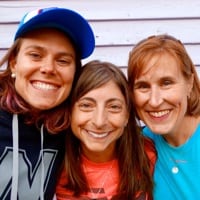From Pam:
Yearly statistics on ultrarunning show that less than 30% of the participants are women. Yes, women are well represented in trail 5k’s and half marathons, but even at the marathon distance on trails, women’s participation drops off rapidly and is very close to that same 30% as noted in ultras, despite women making up close to 50% of road-running fields. Many have speculated about the number of commitments women have, particularly those women with kids, and that lack of time may be issues. Obstacle racing, where the majority of the races are relatively short in both length and actual duration, shows a strikingly similar trend to ultrarunning, with Tough Mudder reporting that approximately 30% of its 1.5 million participants last year were women. It seems that as races get ‘burlier,’ women’s participation falls, regardless of the distance of the race.
While I am sure there are myriad reasons why women’s participation in ultrarunning is not as high as men’s, I do think one of the reasons is that is just isn’t ‘girlie.’ Please remember that the Barbie doll–with her perfect makeup, closets of fashionable clothes, and loads of stiletto shoes–is the best-selling girls’ toy, EVER. And do you think Barbie runs ultramarathons? Hell no! She’d get plantar fasciitis after a lap around the block with those crazy feet made especially for high heels and she would not look nearly as good in a bikini if her sports bra gave her chafing!
Ultrarunning is a dirty sport, especially when you are talking about trail ultras. I have experienced all of these things at some point in my ultra career (and many of them on a regular basis): blisters, vomiting, chafing in just about every place imaginable, falling, scars, extreme sweating and body odor, pooping in the woods, diarrhea, poison oak, snot rockets, trail bronchitis (with lovely green phlegm), lost toenails, and eating stuff that fell on the trail. Heck, at the end of the Angeles Crest 100 Mile I even had a dead worm in my shoe AND a live beetle in my sports bra! It’s not a glamorous sport. It’s probably no surprise that I was fairly rough and tumble growing up, and that I never owned a Barbie.

Pam and her sister getting dirty at an early age. Photo courtesy of Pam Smith.
I think a lot of women are willing to ‘dip their toes in the mud’ for a 5k or a half marathon–because it is a relatively short period of time to be dirty and it avoids a lot of ‘unsavory’ issues like chafing, eating with dirty hands, running in the dark, and going to the bathroom in the woods. Plus, many of these shorter events are aimed at beginners, with smoother trails and more runnable terrain.
From Liza:
I’ll weigh in as the former Barbie-playing, pink-bedroom-sleeping, and tea-party-going little girl, to add diversity to our commentary.

Liza Howard playing tea time as a little girl. Photo courtesy of Liza Howard.
I think some women do avoid the trails because they’re not interested in getting messy. I used to dread dropping my son, Asa, off at preschool because the road-running moms always looked so perfect in their cute, matching shorts and tops and perky ponytails. They wore full makeup and sometimes perfume. The road-running culture there valued appearance a lot. And, like you said, Pam, trail running doesn’t lend itself to staying neat and tidy.

Ann Trason after finishing the IMTUF 100 Mile in 2013. Photo: Tony Salazar of Tempus Photo Design
Certainly my morning trail running uniform–well-worn clothes already smelling slightly of sweat, a hat to hide my hair, and sotol-scratched legs–made trail running less alluring to that particular crowd. (I realize many female trail runners make more of an effort with their appearance than I usually manage to, but I’m sure there are some women reading who have also felt underdressed around a group of female road runners.)
Ultimately, though, I think more women avoid trail running simply because they are unfamiliar with being on trails. When I try to sell trail running to female friends here in San Antonio, Texas, they tell me they worry about their safety. “I’m afraid of snakes.” “Are there mountain lions?” “I’m afraid of falling.” “I’m afraid of getting lost.” Road running and racing is really straightforward compared to trail running. The road is a known quantity. There are also so many images of female road runners out there that new runners can relate to. “I look like that. If she can do it, I can do it.” I think the majority of images of trail runners make trail running seem less accessible to women.
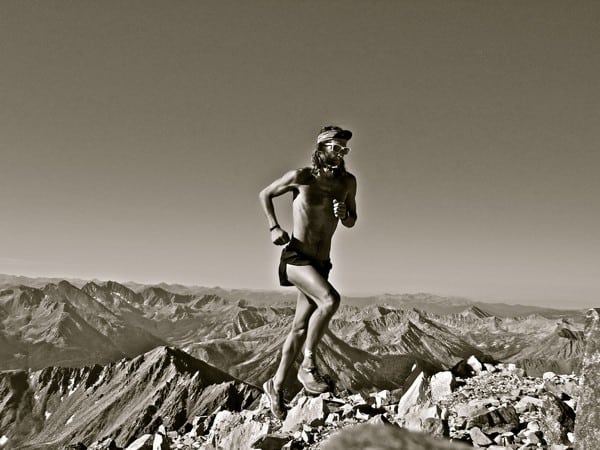
Anton Krupicka training in Colorado’s Sawatch Range in 2013. Photo courtesy of Anton Krupicka.
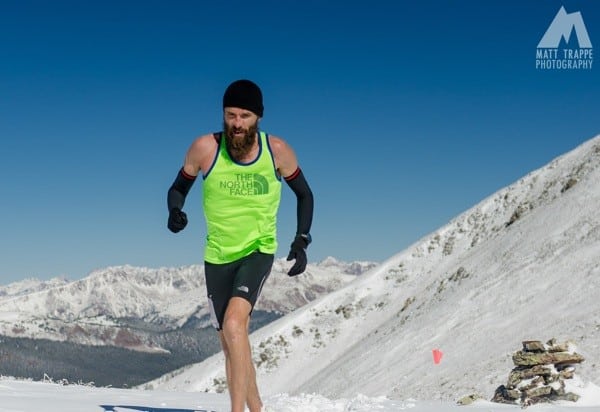
Rob Krar running the 2013 UROC 100k after a fall snowstorm. Photo: Matt Trappe Photography
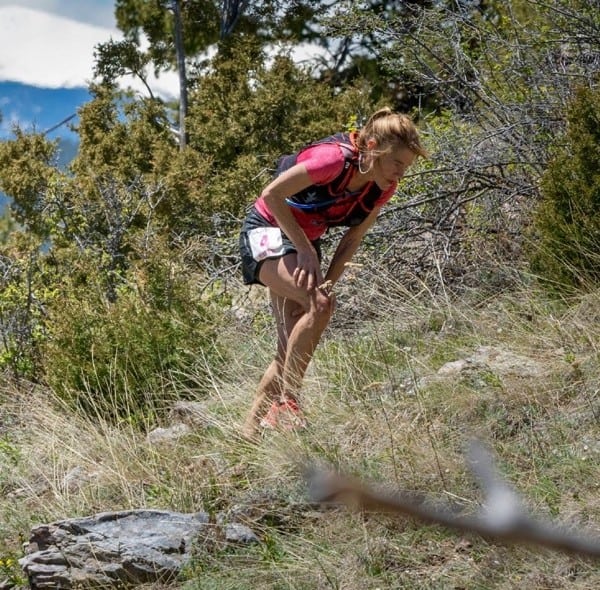
Anita Ortiz racing in ‘burly’ terrain. Photo: Kurt Hardester

Nikki Kimball taking on the very challenging 2014 Marathon des Sables. Photo: Kirsten Kortebein
In the end, I think it’d be a mistake to discount what a big deal going to the bathroom in the woods is to a lot of women. Surely both of you have been asked where you go to the bathroom when you train and race? I’ve heard it almost as much as I’ve heard “I don’t even like to drive 100 miles.” And races don’t cater to female runners in this regard. You can argue about whether it’s a legitimate desire, but I think it’s definitely something that keeps women running road races with port-o-potties stationed every mile or two. As happy as I am to poop in the woods after years working as an outdoor educator, I definitely think the bodily function scene at Marathon des Sables is one of the factors that keeps female participation so low.
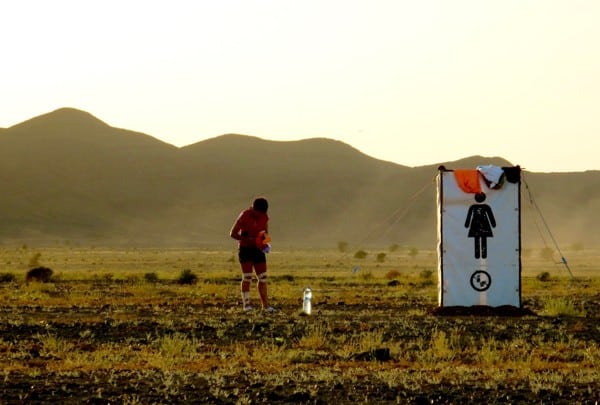
The women’s ‘changing rooms’ at the Marathon des Sables. Photo: Marissa Harris
From Gina:
This may come as no surprise to some, but I grew up playing in the woods, climbing trees, building forts… and loved every second. When I attempted the more ‘girly’ way of things, my little sister would make me be Ken when we played Barbies. I suppose she didn’t like it when I would have Barbie shopping for climbing gear instead of stilettos, so she gave me what she should was the more appropriate role to play. But to me, Barbie was a kick-ass outdoor chick. She could do everything the boys could.
When I was a kid and a game of tag was put together, it seemed like is was composed of about 70% boys and 30% girls. Boys seemed to love running around outside, whereas girls were more interested in playing with their My Little Ponies or tea set. Running around the neighborhood was a no brainer for me. It felt much more natural to go outside, explore, and play in nature than to stay inside and play with plastic toys.
I always noticed the difference between boys and girls when it came to the outdoors, but never quite understood it. I assume now, as an adult, that the differences in the ways we played as kids arrived at least in part from social norms we adopted from the world around us. Females were perceived as the weaker and more gentler sex. We were made to wear dresses, cook, and cater to things inside the household. We were too emotional and easily upset. As for guys, their stereotype was to be tough, do labor/work, provide security. Their appearance was acceptable regardless of what they did, and because of their tough exterior, emotional thoughtfulness could fall short. Growing up with these biased opinions or stereotypes can set the stage for a person’s decisions and interests.
When it comes to trail and ultrarunning, I believe most women define the sport as intense, dirty, unsafe, and unbecoming. The aggressive nature of bounding down dangerous, muddy trails where you might encounter a another forest dweller could make a woman feel less attractive to a potential mate.
Ironically, road running has many of the same distinctions, so the participation numbers make things quite curious. I’ve run many 5k’s in sub-par weather where I ended up looking like a drowned rat. As for the danger factor of falling, I find running on pavement in the winter much more treacherous as compared to trails. I’ll happy dodge rocks and roots versus negotiating slick, icy sidewalks any day. For the women worried about animals on the trails, sure there is a possibility you might see a bear one day, but how about all the human predators who have easy access to picking you up off the sidewalk or side of the road?
From Pam:
Liza said she thinks more women aren’t on the trails simply because they aren’t familiar with the trails. It seems like so many of the women in trail running were ‘nurtured’ in to the sport, like Gina who grew up playing in the woods. My dad was a road runner but my family did lots of trail hikes, so moving to trail running wasn’t out of the box for me.
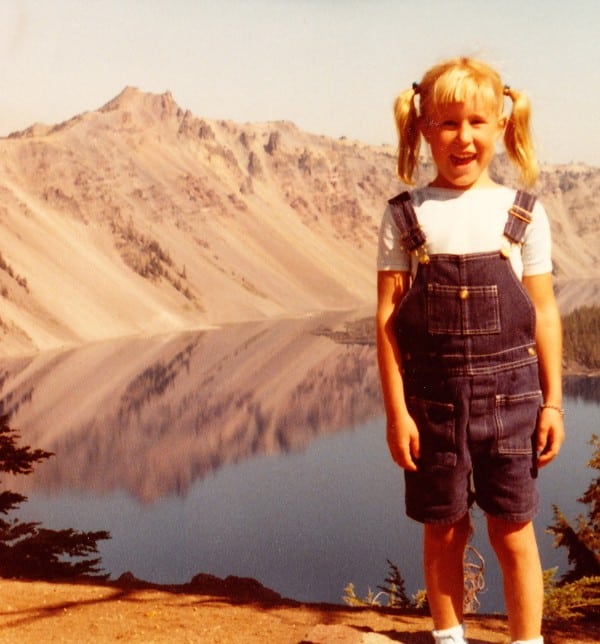
Pam Smith at Crater Lake as a kid. Photo courtesy of Pam Smith.
Whether you think ‘girlie’ behavior is ‘nature’ or ‘nurture’ in women, the fact exists that trail running can be a dirty sport and not necessarily in line with being feminine. But as trail running has become more mainstream, I think a lot of retail companies have helped to make trail running more appealing to women: there’s been an explosion of running skirts and even dresses, there are clothes with cute designs and women’s themes, and more women-specific products. But as a community, I think we need to find ways to keep encouraging women to get into the sport and to help them feel comfortable on the trails. I know I poked fun of a few ladies running the Lake Sonoma 50 Mile with full eye makeup earlier this year (I was in a dark place; it wasn’t personal), but if that’s what it takes to get more women out on the trails, I say bring on the Maybelline sponsorships!
[Editor’s Note: iRunFar has previously explored this idea. Check out the Trail Sisters’s article from earlier this year, which puts numbers on the specifics of gender disparity at various trail-race distances. Also, check out Ellie Greenwood’s article from 2012, which focused on creating a discussion on why women are generally participating less in ultras than men.]
Call for Comments (from Meghan)
- Women, did you find there were gender-based behavior stereotypes presented to you as children? Were there certain activities you were expected to take part in or exempted from because you were a girl?
- Ladies, as a child, did you find yourself bending gender-based expectations and doing things normally ‘assigned’ to boys? In addition to playing outdoors, what other activities did you do that had you sharing the company of more boys than girls?
- Women, were you ‘nurtured’ into trail running with a childhood spent outdoors or adulthood relationships with people who passed on their love of doing things outside? Or do you think its more in your ‘nature,’ that you were born to love trails?
- A question for men and women, future forward, what are some things we can do to increase women’s participation in ultrarunning now and to raise the next generation of women who will feel comfortable being ‘dirty’ if they choose to be?
